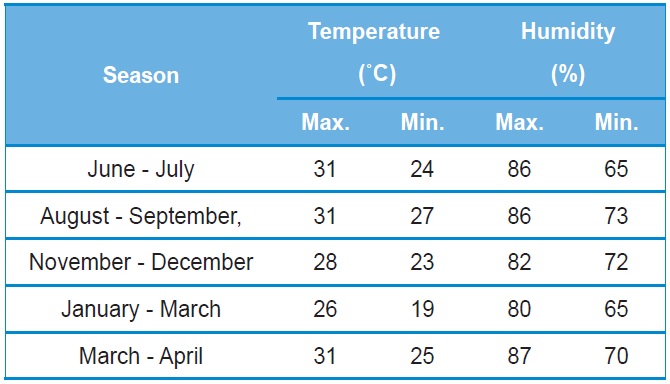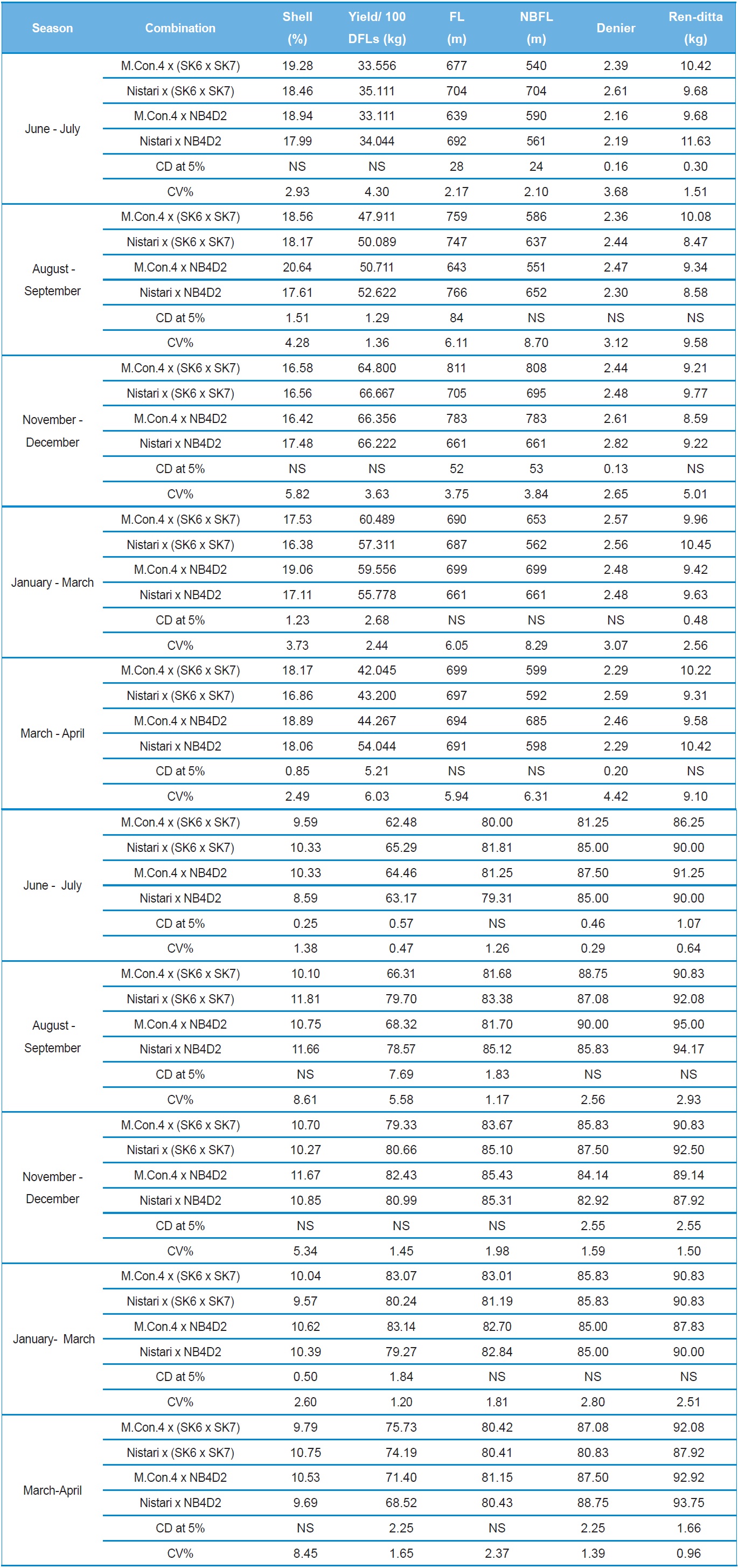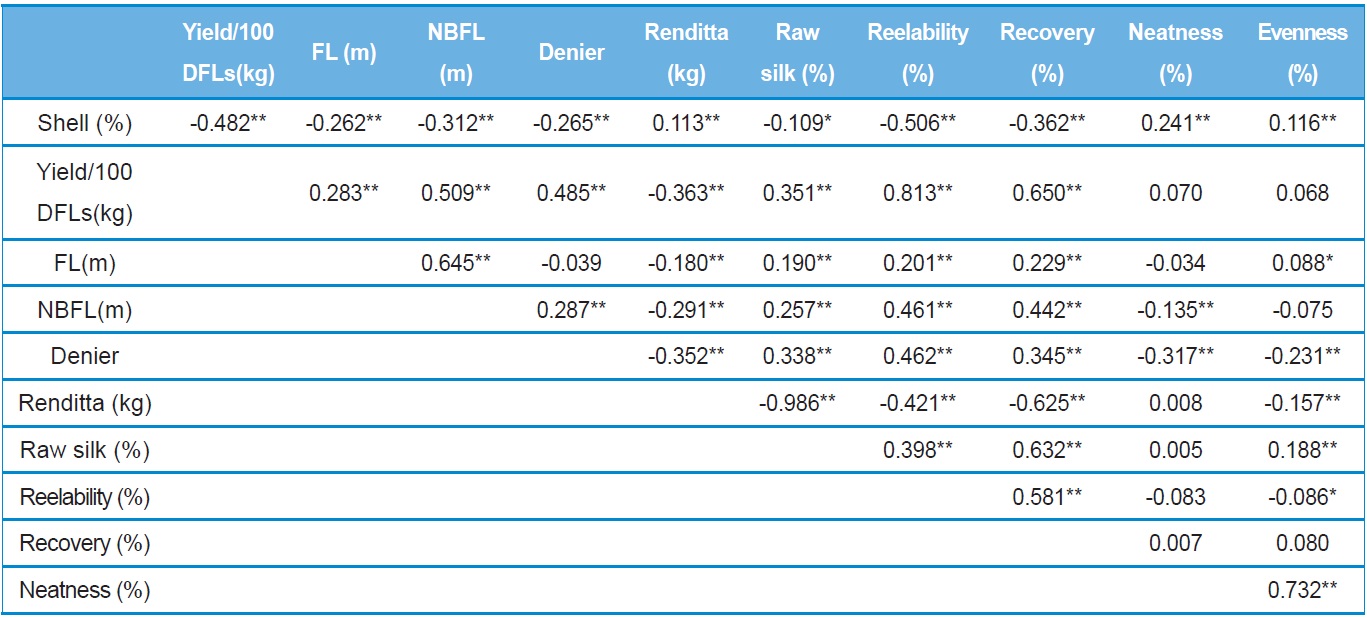



Genesis of quality and quantity of mulberry silkworm cocoons is a challenge for West Bengal ? a state of tropical atmosphere. Quality and quantity of silk produced by Multivoltine x Bivoltine silkworms is better than the silk produced by Multivoltine x Multivoltine silkworms. Adoption of Multi x Bi rearing by the farmers of West Bengal is an approach to meet the challenge. Breeders are engaged in search of season specific suitable breeds/hybrids aiming to provide sustainable productivity at field level. Some Multi x Bi hybrids have already won popularity among farmers. From the commercial point of view yield of cocoons per 100 DFLs and shell percent hold the crucial role. Silk ? produced by reeling of cocoons is the main commercial parameter (Reddy
Two multivoltine breeds M.Con.4 and Nistari and two bivoltine breeds (SK6 x SK7) and NB4D2 were selected for this study and the experiment was conducted at the Silkworm Breeding and Genetics Section, Central Sericultural Research and Training Institute, Berhampore, West Bengal. Cocoons produced by 3 Multi x Bi hybrids viz. M.Con.4 x (SK6 x SK7), M.Con.4 x NB4D2 and Nistari x (SK6 x SK7) were considered as test materials against the traditional Multi x Bi combination Nistari x NB4D2 ? the control.
>
Rearing and Reeling procedure
Three replications @ 400 worms per replication after 3rd moult per combination were maintained throughout the rearing period after 3rd moult. Twenty five good cocoons from each replication of each combination were assessed for cocoon weight, shell weight, and shell percent. For assessment of reeling parameters 300 g of green cocoons from each replication of each combination were dried in hot oven. The drying chamber was heated upto 120℃. The cocoons were then put into drying chamber to remove moisture mixed with the air inside the cocoon at faster rate, so that inner layer sericin is not affected. The cocoons were subjected to drying schedule of 115℃ (one hour) → 100℃ (one hour) → 85℃ (one hour) → 70℃ (one hour) → 55℃ (one hour). Hot air dried cocoons were conditioned for a minimum period of 2 to 7 days in atmospheric conditions. The length of the filament was measured using epprovette fitted with meter. Other reeling parameters were studied following standard procedures.
Correlation among shell percent, cocoon yield per 100 DFLs and nine reeling parameters viz. FL, NBFL, denier, renditta, reelability percent, raw silk percent, neatness and evenness were estimated as per standard procedures.
Analysis of variance was applied for each character for above mentioned five seasons
Data in Table 1 shows the average temperature and humidity
[Table 1.] Season wise temperature and humidity of the rearing room

Season wise temperature and humidity of the rearing room
of the rearing room in different seasons. Highest temperature and humidity was observed during the period 30th August - 23rd September. Suitable temperature and humidity for silkworm rearing was observed during the season November - December.
[Table 2.] Impact of different seasons on shell percent, yield / 100 DFLs and reeling parameters

Impact of different seasons on shell percent, yield / 100 DFLs and reeling parameters
>
Seasonal influence on productivity and reeling performance
Effect of temperature and humidity prevailed in different seasons on the productivity and reeling performance has been given in Table 2. Analysis of results reveal that all combinations of Multi x Bi performed better during the season November- December concerning yield per 100 DFLs ranging from 64.8 kg in M.Con.4 x (SK6 x SK7) to 66.667 kg in Nistari x (SK6 x SK7) without showing any significant difference among the combinations. Performance of filament length ranged from 661 m in Nistari x NB4D2 to 811 m in M.Con.4 x (SK6 x SK7) and
[Table 3.] Correlation among different traits of four combinations of silkworm, Bombyx mori

Correlation among different traits of four combinations of silkworm, Bombyx mori
NBFL ranged from 661 m in Nistari x NB4D2 to 808 in M.Con.4 x (SK6 x SK7). Renditta i.e. requirement of green cocoon to obtain 1 kg silk yearn, raw silk percent, reelability percent and recovery percent showed better performance in M.Con.4 x NB4D2 8.59 kg, 11.67%, 82.43% and 85.43% respectively. No significant difference was recorded among other combinations for these four economically important characters. Significantly higher performance (P<0.05) concerning neatness and evenness was noted in M.Con.4 x (SK6 x SK7) (85.83% and 90.83% respectively) and Nistari x (SK6 x SK7) (87.50% and 92.50% respectively). No significant result was obtained in shell percent during the season November-December. Among five seasons lowest shell percent was observed during November-December, ranging from 16.42% in M.Con.4 x NB4D2 to 17.48% in Nistari x NB4D2.
Highest shell percent was recorded during the rearing season August-September in M.Con.4 x NB4D2 (20.64%) followed by 19.28% during Shravani in M.Con.4 x (SK6 x SK7), 19.06% in M.Con.4 x NB4D2 in Falgooni and 18.89% in Baisakhi in M.Con.4 x NB4D2.
Lowest yield per 100 DFLs was observed in all combinations during the season June-July, ranging from 33.111 kg in M.Con.4 x NB4D2 to 35.111 kg in Nistari x (SK6 x SK7) without showing any significant difference among yield. During the season highest renditta (11.63 kg) was observed in Nistari x NB4D2.
In all seasons recovery percent, neatness and evenness showed >80% result in all combinations.
>
Impact of seasons on reeling performance
Reelability percent was lowest in the season June-July for all combinations ranging from 62.48% in M.Con.4 x (SK6 x SK7) to 65.29% in Nistari x (SK6 x SK7) followed by the seaso August- September ranging from 66.31% in M.Con.4 x (SK6 x SK7) to 79.70% in Nistari x (SK6 x SK7), In March-April season it was ranging from 68.52% in Nistari x NB4D2 to 75.73% in M.Con.4 x (SK6 x SK7), it was 79.33% in M.Con.4 x (SK6 x SK7) to 82.43% in M.Con.4 x NB4D2 in November- December season and it was from 79.27% in Nistari x NB4D2 to 83.14% in M.Con.4 x NB4D2 during the rearing season January-March.
Comparatively finest denier was observed during June-July in M.Con.4 x NB4D2 (2.16) and Nistari x NB4D2 (2.19) followed by 2.39 in M.Con.4 x (SK6 x SK7) and 2.61 in Nistari x (SK6 x SK7).
Raw silk percent was highest (10.70%) during November- December in M.Con.4 x (SK6 x SK7). In Nistari x (SK6 x SK7) highest raw silk percent (11.81%) was observed in August- September, in M.Con.4 x NB4D2 highest raw silk percent (11.67%) was observed during November- December and in Nistari x NB4D2 highest raw silk percent (11.66%) was recorded during August-September season.
>
Correlation among different parameters
Studies on correlation (Table 3) among shell percent yield per 100 DFLs and reeling parameters indicate the positive correlation of shell percent with renditta, neatness and evenness. Yield per 100 DFLs was highly correlated with FL, NBFL, denier, raw silk percent, reelability percent and recovery percent. Positive correlation of FL was recorded with NBFL, raw silk percent, reelability percent, recovery percent and evenness. NBFL showed positive correlation with denier, raw silk percent, reelability percent and recovery percent. Denier had positive correlation with raw silk percent, reelability percent and recovery percent. Significantly higher negative correlation of renditta was observed with raw silk percent, reelability percent, recovery percent and evenness. Positive correlation of raw silk percent was observed with reelability percent, recovery percent and evenness. Reelability percent was highly correlated with recovery percent. It was observed that neatness was positively correlated with evenness.
Concerning productivity and reeling parameters, better performance of all Multi x Bi combinations in November- December season is attributed to the fact that the temperature and humidity maintained in the rearing room in this season is ideal for better performance. Highest filament length was observed in the period in M.Con.4 x (SK6 x SK7) establishes the superiority of this combination in respect of the most important economic trait related with the productivity of the hybrid (Chattopadhyay
Variation in reelability is according to specific breed, rearing seasons and the cocoon produced by male/female. Due to high temperature it is reported that sericin degenerates and the reelability and raw silk percent declines.
Less variation in denier among different combinations in different seasons reveals less impact of the season on evenness character of the resultant raw silk thread. Shell percent of silkworm and the yield/100 DFLs are the most important characters and are directly related with the production of silk. Po sitive correlation of shell percent with renditta observed by Sonwalkar (2001) has also been recorded in this study.
Better quality of silk produced by Multi x Bi is ascertained from the positive correlation of shell percent with neatness and evenness. Higher raw silk percent establishes better neatness character of the filament of the silkworm combinations considered for this study. Positive correlation between yield/100 DFLs and filament length recorded in this study is agreed with the observation of Sekharappa
High correlation of yield per 100 DFLs with reelability and recovery percent confirm that quality characteristics of the cocoons develop during the growth phase of the silkworm and need extreme care as cocoon quality contributes to the tune of about 80% of the raw silk quality (Shimazaki, 1964; Nagadevara, 2004). High negative correlation of renditta with raw silk percent and recovery percent strengthen the view that these variables vary in the contrary direction. High correlation of raw silk percent and recovery percent imply that better the recovery of silk from cocoon better the percent of raw silk. It is also confirmed that better recovery of silk is resulted from better reelability. High correlation of neatness with evenness substantiate the better quality of silk produced by the hybrids.
Higher cocoon yield, reeling and raw silk percent with better silk quality in neatness and evenness recorded in M.Con.4 x (SK6 x SK7) followed by M.Con.4 x NB4D2 and Nistari x (SK6 x SK7) recommend these combinations to be utilized at commercial level to increase productivity of quality silk.


